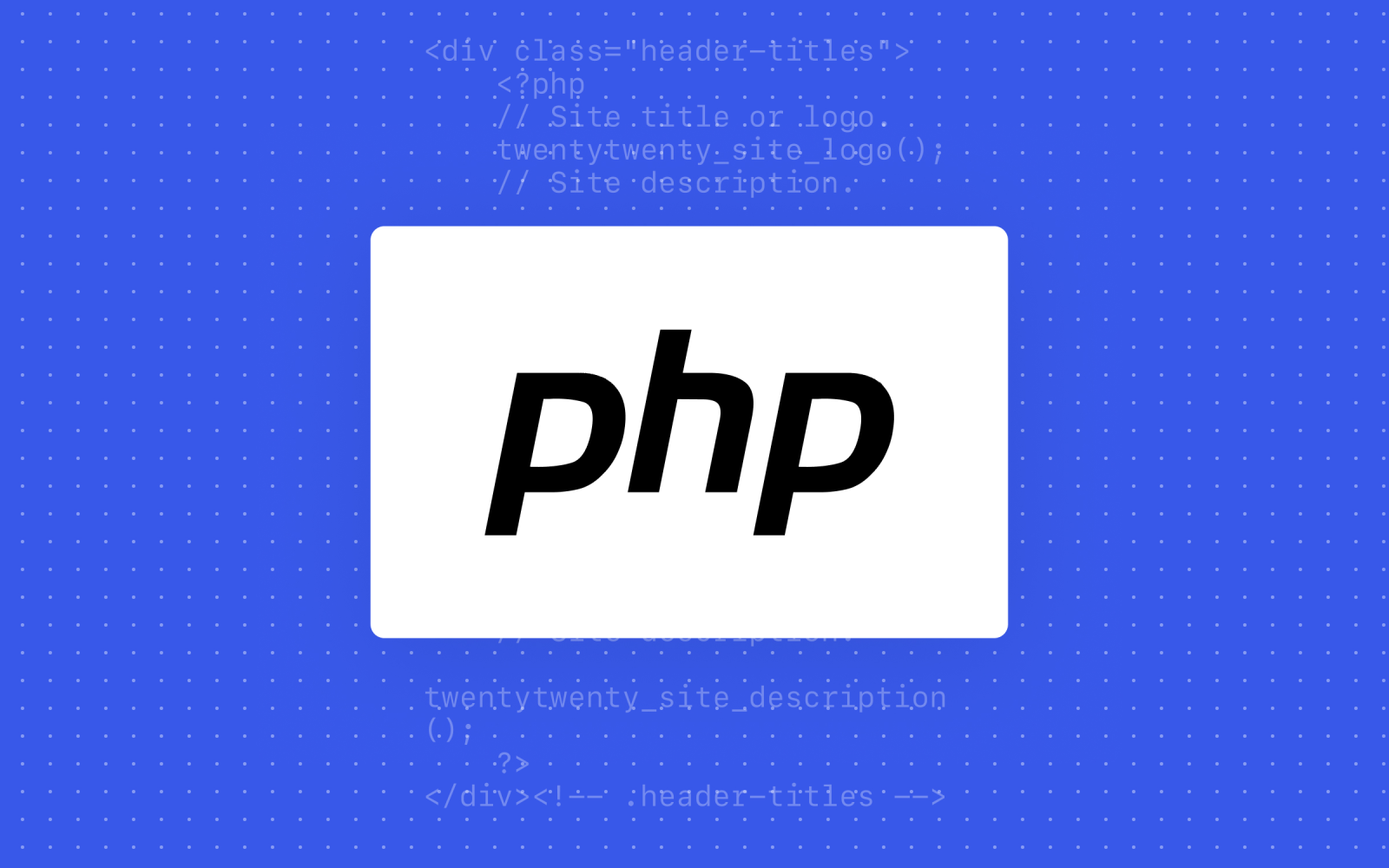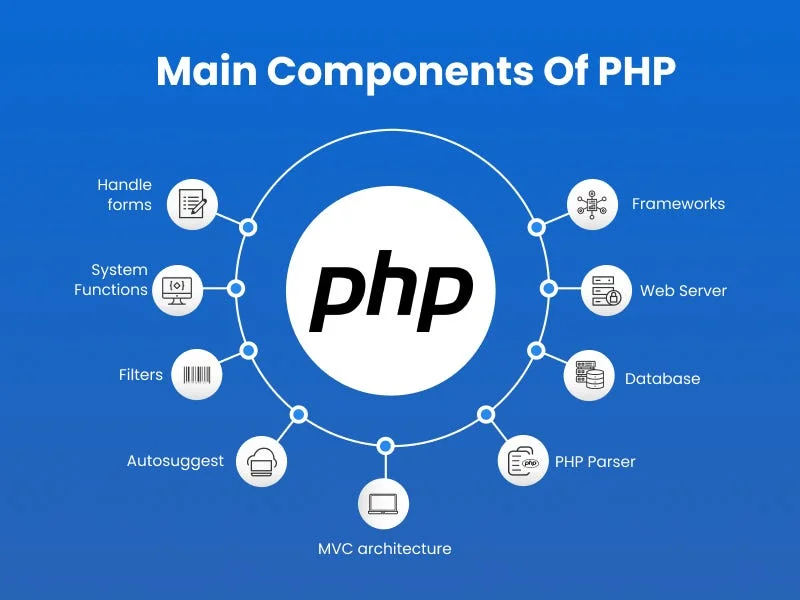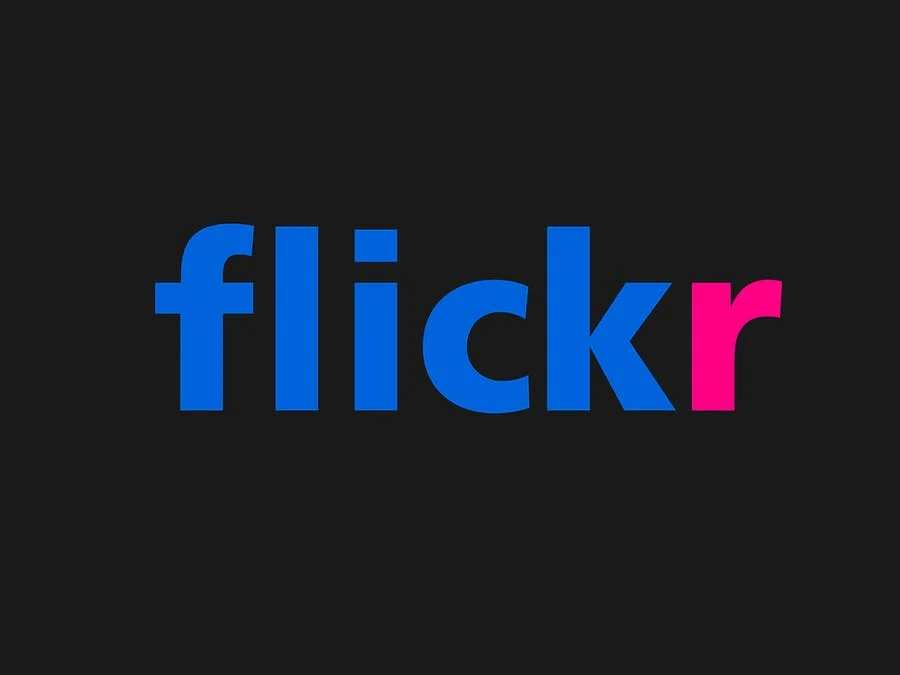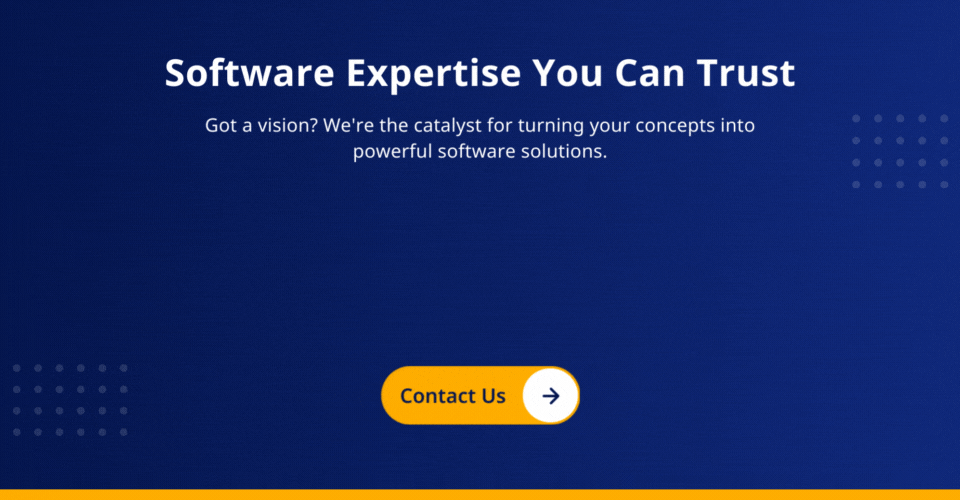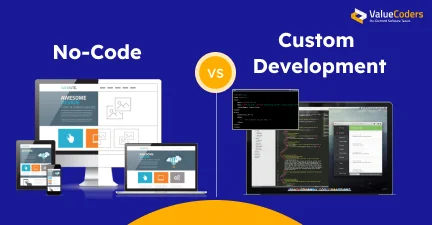Do You Know?
– 45224 corporations reportedly use PHP in their tech stacks, including Slack, Facebook, and Delivery Hero.
– PHP with 33.7K GitHub stars & 7.2K GitHub forks.
If you’re looking to get started with PHP or are simply looking to know more about this powerful language, read on to find out everything you need to know to start using PHP today!
What is PHP?
While most people think of dynamic web pages as HTML, CSS, and JavaScript, they’re missing that behind those pretty designs are server-side technologies — that’s where PHP comes in.
It’s a simple yet powerful programming language designed for web development that allows you to create complex and visually appealing websites.
Although it’s not nearly as popular as other languages like Java or C++, it’s still one of the most widely used languages on sites like Facebook and Wikipedia.
If you are thinking of developing a top-notch web application for your corporation, hire dedicated PHP developers from a reliable PHP development company.
A Quick History of PHP
PHP has grown into one of today’s most popular server-side programming languages from its humble beginnings as a Perl-based web scripting language.
Initially developed by Rasmus Lerdorf in 1994, it was a formal project under development by Stig Bakken and Andi Gutmans in 1997. It received widespread popularity after being posted on Usenet in April 1998.
A couple of years later, Zeev Suraski and Andi Gutmans re-written the significant portions of its codebase for stability. As an open-source project, it is maintained today by thousands of developers worldwide. In addition to WordPress, Drupal, Joomla!, and Magento all use PHP as their core language.
The Popular And Latest Versions of PHP
PHP language runs on most operating systems (including Windows, Mac OS X, Unix, and Linux) and can be accessed through more than 20 different servers, including Apache, Microsoft IIS, and OracleiAS.
PHP has been around since 1994, and it’s had lots of versions over the years. Here view the list of the most used and latest versions of PHP.
PHP Version 1.0
In 1995, Rasmus Lerdorf created a simple set of files that could be uploaded to a web server. Personal Home Page Tools (PHP Tools) allowed web developers to add dynamic content without knowing how to program in HTML. The PHP Version 1.0 includes support for basic HTML tags, variables, flow control statements, and database access.
The first public release of PHP came out on June 8th, 1995, with version number 0.71. This first version was not yet trendy because it required you to recompile your source code every time you wanted to test something out.
However, it already included many features such as:
GET/POST variables; file uploads; session support; cookies; password protection; MySQL database support; output buffering; error handling; register_globals option off by default (on by default since 4); track_vars off by default (on by default since 4); magic quotes off by default (on by default since 4).
PHP Version 2.0
Rasmus Lerdorf developed it in 1994. The main goal of PHP 2.0 was to turn it into a full-scale scripting language that is both robust and easy to use.
One addition was support for object-oriented programming features such as inheritance, polymorphism, and dynamic typing via optional static typing support.
It also allowed developers to create standalone HTML applications; some web servers that are written in PHP have provided these features themselves, so web developers can build fully dynamic websites using nothing but HTML and PHP code without requiring a separate templating engine as they would need with ASP or JSP.
PHP Version 3.0
PHP 3 was released on June 22, 2000. It was to be called PHP/FI (where FI stood for Framework Integration) but was renamed due to a trademark issue with a large German software company that resulted in Zend being able to continue using the name PHP.
This version included many improvements and new features such as user-defined classes, register_globals, type hints, and default arguments.
It has been argued that web hosting companies were reluctant to upgrade due to incompatibilities with Apache 1.3 (which accounted for over 65% of web servers at that time). Around late 2001 or early 2002, between 50 and 60% of servers running version 2.
PHP Version 4.0
The first major update to PHP, version 4.0, was released in 2001 with a complete rewrite of PHP. It included new features like an HTML parser, automatic memory management, and support for object-oriented programming (OOP).
The 4.0 release also saw significant improvements to performance and scalability that allowed for larger websites and applications.
In 2008, version 4.1 brought some major changes to both coding syntaxes as well as adding support for Unicode character strings, streamlining shared memory usage in multi-threaded servers, and adding support for regular expressions in string manipulation functions.
PHP Version 5.0 and 6.0
In 2002, a new version of PHP was released: version 5. This came after several years without an update, and development had stalled due to disagreements within its community.
The new version, however, set forth a roadmap for future development, which included broad support for object-oriented programming and advanced database integration with SQLite and MySQL. It also brought about many improvements in performance.
The significant changes mainly were under-the-hood; some syntactical constructs from previous versions were removed or deprecated in favor of newer constructs that would be more efficient or flexible.
PHP 6.0 was released in 2004, with a new object model and support for Unicode and several SQL databases, including Oracle, PostgreSQL, and DB2. This version was intended to be compatible with C++ but fell short due to several compatibility issues that were not resolved until later versions.
It was also criticized for being too complex and having many inconsistencies in its implementation; its developers thus deprecated it within a year of its release.
Latest PHP Version 7.0
PHP Version 7 is utilized by 71.5% of all websites.
Released in December of 2015, version 7.0 was delayed as core developers worked to fix major security flaws before officially launching it. The latest iteration includes performance improvements, such as better garbage collection and overall code cleanup, including more consistent and uniform syntax.
PHP 7 can run twice as fast as PHP 5. Beyond performance boosts, version 7 also includes three new built-in data types:
- Fixed-size array.
- The ability to declare variables without explicitly assigning values.
- Tuples (an ordered container).
Other additions include support for Unicode 8.0 and Internationalization APIs (Unicode Normalization and Namespace Separation). Additionally, version 7 has new syntax for anonymous classes, improved support for generators and coroutines, and a new Opcache component that replaces APC.
In addition to improvements for developers, version 7 also includes several changes geared toward making it easier to deploy secure applications.
For example, there is built-in support for X.509 certificates, and OpenSSL engine 1.0.2d has been included as part of the core distribution (previously, it was a PECL extension).
The language itself is more secure as well, with updated escaping rules and better error handling. This new version is already available on most Linux distributions, such as Red Hat Enterprise Linux (RHEL) 7, Ubuntu 15.10, and Debian 8 Jessie.
Here are the key features of PHP that help make it one of the universal languages around…
Cross-platform compatibility
One of PHP’s main selling points is its cross-platform compatibility. You can use a single code set to produce web applications, whether for desktop PCs running Microsoft Windows or Apple Macs, tablets running Microsoft Windows and Android, or phones powered by Apple iOS and Google Android.
And, because there’s an abundance of free, open-source tools available for all these platforms, you don’t have to spend money on software development environments that you may only need once in a while. You can also access any existing code libraries as well as install new ones directly through your browser.
Loosely typed language
Also referred to as weak typing, a loosely typed language is one in which variables can be used without declaring their type. These languages also allow some data types to be converted into other types as necessary.
Loosely typed languages often use explicit casting methods if you wish to explicitly change a variable’s type. In PHP, int and float can be cast into string objects with functions like intval() and doubleval().
Type conversion is automatically applied by loose typing when needed. Still, casting provides an easy solution in those cases where it isn’t. Making use of loosely typed languages doesn’t require you to spend much time on data type declarations or conversions that aren’t strictly necessary — you can just get right down to creating your application.
Error reporting and exceptions
You can tell your program to throw an exception, which sends it into panic mode and interrupts its flow. When that happens, the execution of your program will stop, and you’ll be notified about what went wrong.
Errors during runtime aren’t easily predicted or solved ahead of time because they arise in response to changing conditions. (You could think of them as bugs.).
This flexibility is one reason why error handling with exceptions is such a great tool: it works well with a dynamic language like PHP. It allows you to respond quickly to unpredictable events.
Throw in some advanced debugging techniques, like SQL queries and profiling, and you can start identifying problems before they cause too much trouble.
Real-time access monitoring
This is a feature that allows web hosts to watch for multiple users trying to access a server at once and thus be able to control how many users can use that particular server at one time.
Although in most cases, most hosting providers won’t let you run into problems, there are some limits on what can be accessed on your server depending on how many other people are also using it.
For example, if too many people try to access Facebook or some other popular site at once, they may experience slow response times and/or difficulty accessing it together.
Another issue that can come up with being unable to access your website is not being able to receive mail if you have a web-based email service like Gmail or Yahoo Mail.
Object-oriented features
Another advantage that PHP has over other web programming languages is its object-oriented programming (OOP) support. OOP allows you to create more dynamic and modular applications and makes it easier to create reusable code.
One of PHP’s key strengths is its robust set of libraries, which allow programmers to reuse existing code instead of rewriting everything from scratch. In a language like Java, where there is no native support for OOP, most web PHP development work is done using frameworks built with JavaScript.
Memory and CPU usage information
If you’re looking to learn more about optimizing your coding, there are a few tools that can be invaluable. First and foremost, there’s xdebug_memory_usage(). This gives you a good idea of how much memory your script uses.
If you want to get an even better idea about memory usage in real-time, xdebug has an extension called magic_quotes that puts a dot on top of any strings that were escaped by magic quotes (an old function for those who used PHP4).
The fun part about it is watching strings being passed around and escaping as they go. You will notice memory start to grow as objects/arrays/etc. are instantiated, but then you’ll see it shrink again once they are destroyed.
As far as CPU goes, xdebug also has an extension called profiler, which lets you view detailed information about every single line of code that was executed during a page load.
It’s not quite as exciting as memory profiling, but it does give you a perfect idea about where time is being spent when running through different parts of your codebase.
Magic Constants
In PHP, there is a set of magic constants. A constant is basically a predefined value for something which cannot be changed. They act as operators for comparison and other situations where you want to use a constant rather than using hard-coded values in your program code.
The magic constants are created and automatically added when you do various things like creating arrays or objects, etc. There are four different types of magic constants: boolean, integer, float, and string.
These can be used directly in conditional statements such as if statements, else statements, while loops, and so on. You can also resemble them with each other (for example, with ==) to see if they have equal values or not.
Regular Expression
A regular expression (abbreviated regex or regexp), also known as a rational expression, is a sequence of characters that define a search pattern. Typically, such practices describe strings of text of interest, possibly with some user-defined repetition and flexibility.
The abbreviation regex can be pronounced either to rhyme with the express or rhyme with a check. The difference between these pronunciations is emphasized by Larry Wall in.
In contrast to other typical programming languages, in Perl, regular expressions are primarily used for pattern matching and string manipulation.
Perl 5 added several built-in functions for working with regular expressions. REs have also been implemented in numerous third-party add-on modules available for many programming languages.
PDO Class
The PostgreSQL Data Object (PDO) extension is an interface between PHP and PostgreSQL. For each database connection, there is a corresponding PDO object that implements the four core methods defined by that interface: prepare(), execute(), fetchAll() and close().
This separation makes it easy to open multiple connections simultaneously without running into problems with name collisions. And, if you’re using namespaces, that simplifies things even further.
Though not required for correct code under PSR-0, it’s a recommended best practice to define classes that contain these PDOs in their namespaces and use autoloading so your application can quickly load them.
Additional Features
The list of features is never-ending. PHP includes handling images using the GD library, making remote connections with cURL, managing the file system, using sessions to track login details, using SimpleXML Class to read and write XML files, and making the best use of cookies and sessions.
Additionally, it supports the shell commands in command-line execution, has the ability to compress zip archives, and is capable of taking full advantage of Ajax.
The features & functionalities of PHP can be used appropriately, but for that, you may require to connect with the top PHP app development company to hire dedicated PHP developers. By doing so, you will be able to make adequate use of the technology in web app development.
For More Info Read This: PHP Is Incredibly Better Than Its Other Alternatives For Web Projects
Reasons Why PHP Is An Excellent Option For Web Development
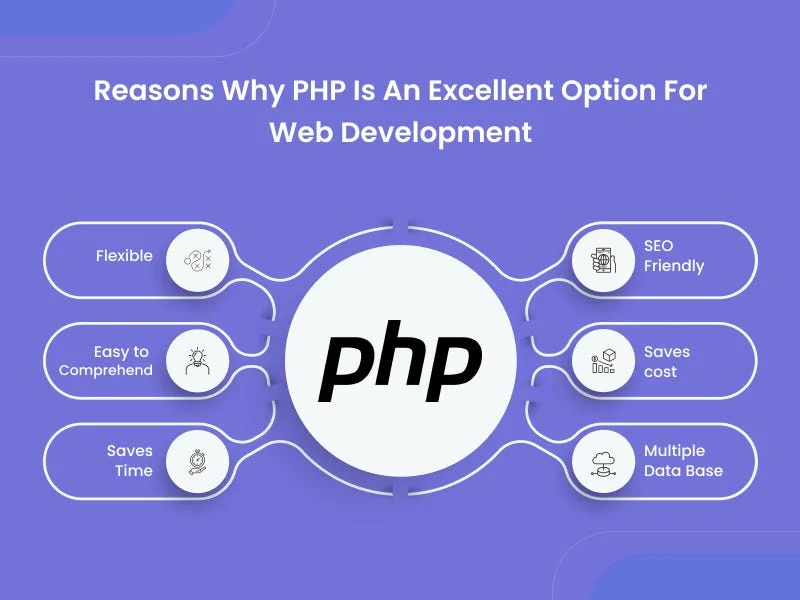
In today’s competitive tech market, it’s tough to decide on which programming language you should go with. New languages are popping up every day, and each one of them seems more impressive than the last!
However, if you’re looking to build web applications or sites, there isn’t any competition — PHP is the hands-down best language for this type of work. Here are just a few reasons why PHP is the best programming language for web development.
High-Level Security
Another big reason people love PHP is that it’s a secure platform. Unlike other platforms, you don’t have to run any code from memory to use it — all code runs from disk.
And thanks to its high level of integration with Apache and MySQL, there are fewer security risks. Using three layers of protection (PHP itself, Apache, and MySQL), you’re unlikely to encounter any problems with hackers or viruses.
And even if you do, those three layers mean your site will be protected until you can get things sorted out. It’s simple to see why so many developers have chosen PHP over other options when building their next application!
Fast Load Time
One of the reasons PHP has been so popular in recent years, especially with web developers, is its speed. Not only does it execute quickly, but it loads sites quickly too.
Combining those two things makes your site’s overall performance much better than that of its competitors. You can almost always increase a page’s conversion rate by using a scripting language like PHP instead of one like ASP or JSP.
And since visitors are most likely to abandon a page if it takes too long to load, using a language that reduces load time can increase profits from increased engagement.
Less Expensive Software
When you run a website, you need to be sure that your cost of operation is going to be reasonable. As a simple, lightweight scripting language, PHP requires far less memory than more complex languages like C++ and Java, which means that you’ll need fewer hardware resources.
This can translate into lower software and hardware costs (if you’re outsourcing), making it easier to start an online business. As a result, websites built in PHP tend to have much shorter learning curves, reducing training costs.
If your budget is tight when starting up, consider choosing a language like PHP — it will certainly help keep your costs down during those first crucial months!
Ease of Use
While PHP may not be as powerful as some of its more advanced competitors, it’s nevertheless extremely accessible. To work with it, you don’t need to have formal programming training — if you can read and follow directions, you should be able to get started in no time.
And that’s what makes it such a popular option among new developers: You don’t need special skills or software to begin working with it; all you need is a text editor and access to a server.
Even if you’ve never developed anything before, getting up and running with PHP takes very little time & effort on your part; in contrast, learning other languages like Ruby or Java would mean beginning from scratch.
Simplicity
Using PHP, you can create a dynamic website in minutes. You need to open up your favorite text editor and start typing code. There are no complex steps involved, no compiling required, and no special tools needed (though there are many useful add-ons). As long as your server has PHP installed, you’re good to go!
Database Flexibility
For example, if you decide later on that you want to switch from MySQL to PostgreSQL because of a unique project requirement, it’s easy to do so by writing some code. There is a multitude of other database servers that can be plugged into PHP just as easily.
Additionally, using drivers written in native code allows you to access database features not available through standard APIs, such as prepared statements and stored procedures.
Because all database access through native drivers uses one standard API, there’s less confusion about what kind of queries should or shouldn’t be run against which databases and when to use each.
Database-agnostic systems make it easier for developers to switch between different databases, making things more complicated because each system has its quirks and requirements.
For Better Clarity Read This: PHP Guide: Vital Things You Should Know About PHP
The Most Popular Popular PHP Frameworks
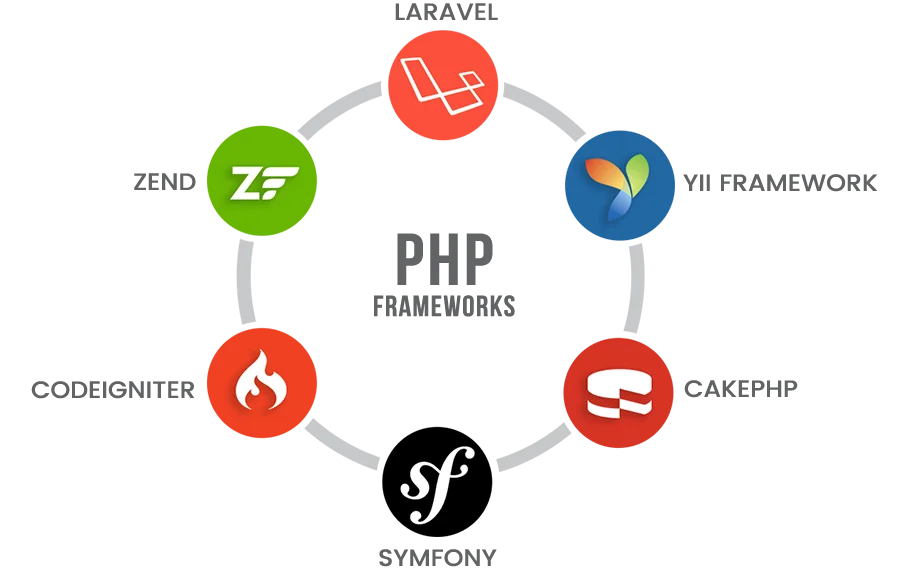
Image Source: Medium
There are hundreds of PHP frameworks available today, many of which you’ve probably never heard of. Here view some of the most popular and widely used PHP frameworks.
Moreover, sometimes making use of the PHP framework can be difficult to resolve such issues get connected with the PHP development company in India as by doing you will be able to hire PHP experts.
Laravel
With an emphasis on minimalism and elegance, Laravel is a developer’s best friend. Laravel powers some of today’s most popular websites, including Kickstarter, Slack, Tesla Motors, Vine, and even Google.
If you’re ready to invest your energy into a growing open-source platform with a passionate community, look no further than Laravel. The framework requires very little configuration before you can jump right in and start writing code.
The documentation is extensive, and free resources like Laracasts provide you with all sorts of tutorials to master each component quickly and efficiently.
Yii2
As a more robust framework, Yii2 is designed to create enterprise websites. This means it may be overkill for smaller websites but is ideal for large sites with lots of traffic and complex backends.
Some standout features include easy command line usage, object-oriented design, MVC architecture (for web apps), and complete test support with coverage reports and DB migrations.
Though not free or open source at its core, it has an open core version and an even cheaper personal license if you’re on a shoestring budget.
Symfony
A web app framework allows developers to use established design patterns and standards to build robust applications rapidly.
It uses a modular, service-oriented architecture approach, has no global state, and separates code from content to easily share reusable business components among projects.
Symfony 2 is not backward compatible with Symfony 1; its new components must be integrated with existing apps.
However, it aims to make integrating those components easier than before, which promises to improve developer efficiency while boosting the speed of development — crucial factors when creating enterprise-level software products and large e-commerce websites.
And because it’s open-source (as are all of these frameworks), users have access to Symfony’s continuously updated community knowledge base for support.
Zend
The Zend Framework project is an open-source software framework for developing web applications and services using PHP 5.3+. Zend Framework includes a range of components based on extensive application usage and feedback from its extensive user base.
The framework follows very closely to Symfony but is not a derivative or fork. It is built with portability and interoperability in mind, with interfaces written in both formal object-oriented code as well as common sense PHPish style, making it easy to integrate into any type of project.
CakePHP
With a built-in ORM, support for major databases, and a ton of 3rd party plugins, CakePHP is one of the best options around. Although it has some growing pains (believe me!), there are plenty of forums and tutorials to help you through them.
CakePHP is a great option if you’re just looking for some basic authentication and authorization without spending days hacking together your own framework.
Moreover, if you need an easy way to develop CRUD apps with a SQL backend, I would recommend using CakePHP. It’s also worth mentioning that CakePHP supports OOP out of the box and allows you to create your own classes in PHP instead of extending core classes as other frameworks do.
In addition, its routing system makes it easy to organize your application’s URL structure. Last but not least, its scaffolding system makes developing CRUD applications even easier by generating all those boring boilerplate files for you!
For More Info Read This: Codeigniter Vs CakePHP Vs Yii Vs Laravel: Which Framework Would You Choose?
CodeIgniter
CodeIgniter offers a quick and easy way to get started for those just learning how to develop web apps. It’s also great for anyone who wants a fast, no-nonsense development environment that is easy to learn.
CodeIgniter’s model–view–controller (MVC) structure helps you quickly build apps with a relatively small amount of code. You can install it on shared hosting accounts if you’re tight on space.
EllisLab created the framework in 2006 as an open-source project. Still, EllisLab has since discontinued its work on CodeIgniter and now offers complete commercial support packages through its partner company, ActiveState.
Related Blog: Top 16 PHP Frameworks To Watch Out
Famous Applications Built Using PHP
There are many great applications built using PHP, and here are five that you may have heard of before.

Image Source: Facebook
The most popular and well-known social media platform was developed using PHP, even though it is built using a mix of languages. Facebook’s main language (at least when initially launched) was based on PHP before transitioning to Hack and then finally to HHVM as they increased their user base.
Facebook uses a complicated web of technologies, so much so that they invented Hack in order to handle their workload.
Yahoo!

Image Source: YouTube
This web portal provides an online internet search service for various information, including news, media, finance, and jobs. It’s also a well-known site for providing answers to questions by employing a simple form.
Yahoo! has been known as one of those companies that create their technology to accommodate thousands of servers and users per day. This allows them to handle any situation on their website without needing third-party software or help from another company.
Yahoo! was developed using a programming language known as PHP Hypertext Preprocessor, which helps create dynamic websites that can instantly respond when more server space is needed due to an increase in traffic or for other circumstances that cause chaos within its website code.
WordPress
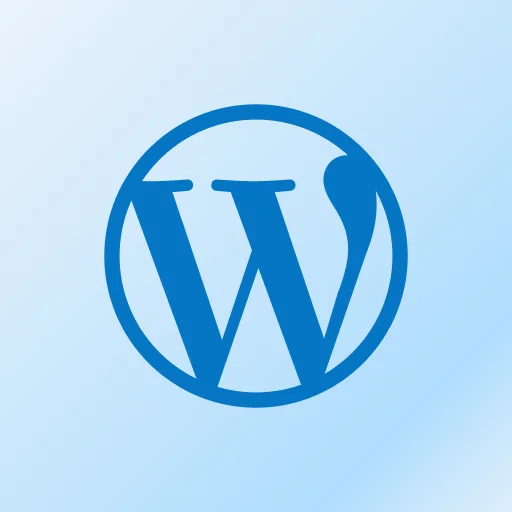
Image Source: Google Play
The self-proclaimed world’s most popular publishing platform, WordPress, is used by over 25% of all websites on the internet. The open-source blogging tool can be used for any website, from simple blogs to complex social networks and community sites. This famous site is built using PHP.
Flickr
Image Source: The Verge
The popular image-sharing site Flickr was created using PHP and launched in 2004. Since then, it has grown to include a collection of user-submitted photos and videos, several mobile apps for iOS & Android devices, and a website that lets you browse your account, upload new content, manage your contacts, and more.
Flickr is owned by Yahoo!, which reportedly bought it for $35 million in 2005. In 2007, Flickr added Places, allowing you to check in at locations with GPS-enabled cameras.
Tumblr

Image Source: Crunchbase
Built by Marco Arment and operated by David Karp since 2007, Tumblr has become one of the biggest social media platforms on which you can share your stories, pictures, and videos.
It is used by more than 500 million people every month and features content in almost any topic area. It is powered by a custom-built app that relies on a database backend hosted on Heroku as well as Redis (for database caching) and Cloudinary (for video and image hosting).
The service handles about 60 million posts per day with an active user base of about 330 million monthly users. When it comes to PHP frameworks, a framework called Aura has been developed for use with Tumblr.
Ending Words
PHP is a great language to get started with coding. It is also one of the most popularly used web development languages in the world, powering some of the largest and most trafficked websites on the internet. If you’re looking for a language that is best for web development, PHP is a great option to consider.
Moreover, to make comprehensive use of the PHP programming language, you can hire PHP developers from one of Top PHP development company in India (ValueCoders) at an affordable rate.
Thanks for reading! We hope this guide has been helpful in getting you started with PHP. Happy coding.
Frequently Asked Questions
What things should you look for before hiring PHP developers?
Before hiring a PHP developer, you should consider their level of experience, skillset, and whether or not they are the right fit for your project. You should also look at reviews from previous clients to get an idea of the quality of their work.
Finally, make sure to ask for a portfolio of their past projects to get an idea of their style and approach to PHP development.
Why should I hire PHP Developers from India?
There are many reasons to hire PHP developers from India; some of them are stated below:
– India has the second-largest number of active PHP developers in the world.
– The cost of hiring a PHP developer from India is significantly lower than hiring one from another country.
– Indian developers are known for their high quality of work and attention to detail.
– Indian developers have a strong understanding of both the English language and western culture, which makes communication and collaboration easier.
What is the difference between Java and PHP?
Java and PHP are two of the most popular programming languages in the world. They are both used for server-side development, but they have some key differences.
Java is a statically typed language, while PHP is a dynamically typed language.
This means that in Java, variables must be declared with a specific data type, while in PHP, variables can be declared without a data type.
Java is also a more complex language than PHP, and it can take longer to learn. However, PHP is easier to use for web development because it has built-in functions for common tasks such as form handling and database access.

